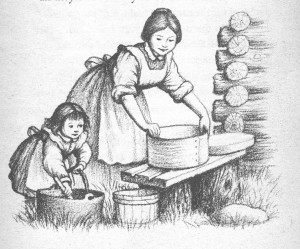I have chosen to focus on chapter 3 of the novel, whilst paying particular attention on the traditional gender roles theme.
Chapter 3- Camp on the High Prairie:
In this chapter, the family start to settle in the wilderness, and is where the traditional gender roles start to appear. The decisions on what to do are made by Pa. This is stereotypical, as men are considered better leaders than women. "We'll camp here a day or two" (Page 27). This demonstrates how the operation of gender roles is seen within the novel as it is suggesting that the family, especially Ma, cannot have a say in this. Pa is being assertive, a role related to males, especially in the 1800's.
Throughout the whole chapter, Pa does not get involved in the domestic chores associated with the home. Instead, he focuses more on the 'survival' roles. "Then Pa raked more coals over the cover, while Ma sliced fat salt pork." (Page 26). This indicates that because Pa is male, his role is to ensure the family survive; making sure there is warmth within the house. Whereas Ma, although also ensuring their survival, her role is much more domestic orientated. As cooking is related to femininity, just like violence is associated with masculinity. "Pa did not seem to move quickly, but he did. In an instant he took his gun out of the wagon and was ready to fire at those green eyes." (Page 28). This proves that Wilder incorporated the gender roles in the novel, because it was what life was like in 1870.
Typical gender roles that the novel presents is the notion of strength and fitness. "She couldn't hold him." (Page 29). This signifies that Ma was not strong enough to defeat the animal that was threatening the family. Whereas Pa was. This also reflects the traditional male hero, saving the family from threats. The idea that Ma is hopeless and helpless, demonstrates how the traditional gender roles are shown.
However, Ma does have some form of authority. "'Bedtime for little girls!'" (Page 28). This shows that despite the mother being portrayed as a sheep to Pa, she does actually have control when it comes to the children. But this is equally a traditional role, as woman look after the children, whilst the father protects them.
There are some surprises with the gender roles. Laura does not fit the stereotypical, traditional gender role. "Mary got up and turned around so that Ma could unbutton her. But Laura jumped up and stood still." (Page 28). This demonstrates that Laura falls into both gender roles, as she is boisterous, yet she is a girl. She wears a dress, but she is also quite rebellious too. She seems interested with nature as opposed to the civilised home. In the 1800's, if the gender did not match the gender roles, it was considered as uncivilised. Despite the family building a home in the wilderness. Laura is portrayed similar to her father, whereas Mary is similar to her mother. This is interesting to add to a novel set in the 1870's, as this would have been unusual.

This image shows that both the girls are both cooking, which is the 'correct' traditional gender role. However, one is clearly in charge, while the other simply watches. This is an example where Laura is similar to her father, as although cooking, she has dominance over Mary, and is in control over the entire task. She also appears much more confident than Mary, as she is not measuring the amount in which she is pouring into the bowl. The body language of both suggest that Laura is assertive, whilst Mary is submissive.

This image illustrates the traditional gender role of the female in operation in the novel. As Ma is teaching the girl how to live within society. Mary clearly has no problem in the female roles. An interesting point is the fact that Laura is not in the image at all. This indicates that she is not portrayed as fitting in with the female role, and is arguably with her father hunting.
The Wall Street Journal:
http://www.wsj.com/articles/SB10000872396390444023704577649541690283760
This review focuses more on other aspects of the novel rather than the operation of traditional gender roles. Instead, the review focuses on the American values and ideology and the lifestyle of the 1800's in America. The idea of the American Dream is being portrayed in the novel, and whether the pioneers were truly free, because of the Government and Indians during this time. It also mentions that the novel is a good book for children as it demonstrates the history of Western America, as well as the values that were associated with America such as, self-reliance.
The New York Times states that Pioneer Girl was number 1 in February 2015, in terms of culture.
Grace La Traille
Sources:
http://www.nytimes.com/best-sellers-books/culture/list.html
www.therightsideofnormal.com
theblueroomblog.org
http://www.wsj.com/articles/SB10000872396390444023704577649541690283760
Wilder, L. (1935) Little House on the Prairie. Great Britain: Puffin Books.
No comments:
Post a Comment